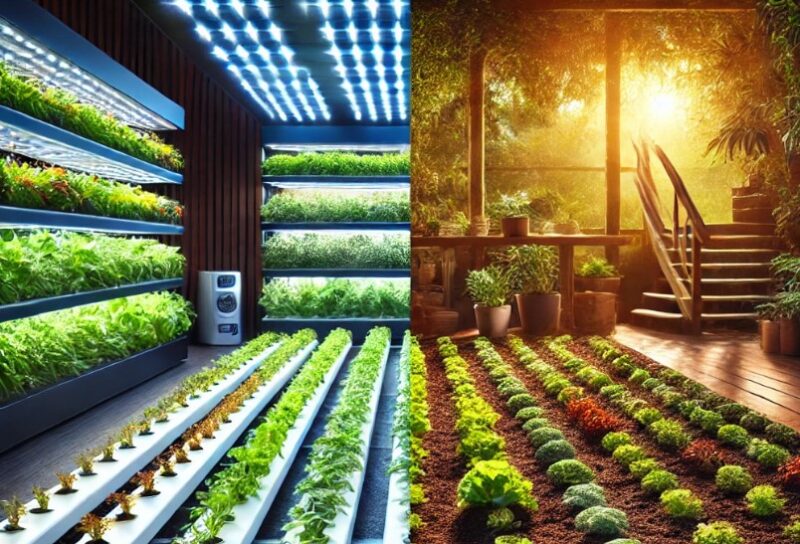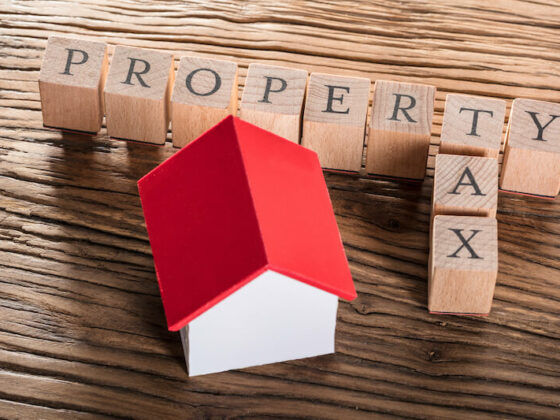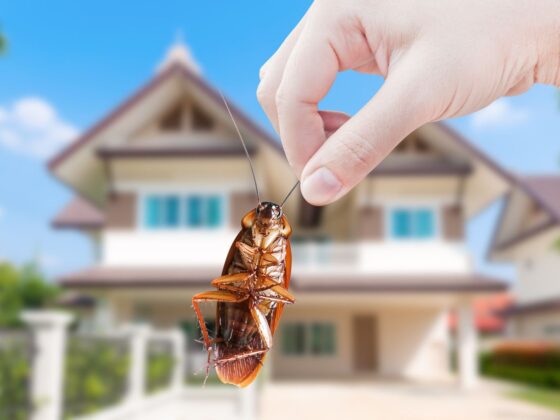As gardening continues to grow in popularity, many people are exploring different methods to cultivate their plants. Two of the most common approaches are hydroponic gardening and traditional soil gardening. While both methods have their own unique benefits and challenges, choosing the right one depends on your specific needs, goals, and environment. In this article, we’ll compare hydroponic gardening and traditional soil gardening to help you decide which method is best for you.
What is Hydroponic Gardening?

Hydroponic gardening is a method of growing plants without soil. Instead, plants are grown in a nutrient-rich water solution that provides all the essential nutrients they need to thrive. The roots are supported by an inert medium such as clay pellets, perlite, or rock wool, which anchors the plant while allowing the roots to absorb the nutrients directly from the water.
Hydroponics has gained popularity due to its efficiency and the ability to grow plants in environments where traditional soil gardening may not be feasible. This method is particularly popular in urban areas, indoor gardening, and commercial farming operations.
Best Tools and Systems for Hydroponic Gardening
When starting a hydroponic garden, choosing the right tools and systems is essential to ensure successful plant growth and maintenance. One of the leading brands in the hydroponic gardening industry is Mars Hydro, known for its high-quality and user-friendly hydroponic systems, including:
● Mars Hydro Hydroline12 LED Hydroponic Growing System: This system is ideal for seedlings and cloning, providing plants with the precise light spectrum they need for early development. The compact design makes it perfect for small spaces, and the LED lighting ensures energy efficiency without compromising plant health.
● Premium Mars Hydro 5-Gallon DWC Hydroponic System Kit: A versatile and robust DWC hydroponic system, this kit includes two 5-gallon buckets and an 8-inch net pot lid, making it perfect for growing larger plants. The deep water culture (DWC) system promotes vigorous root growth by delivering oxygen-rich water directly to the roots.
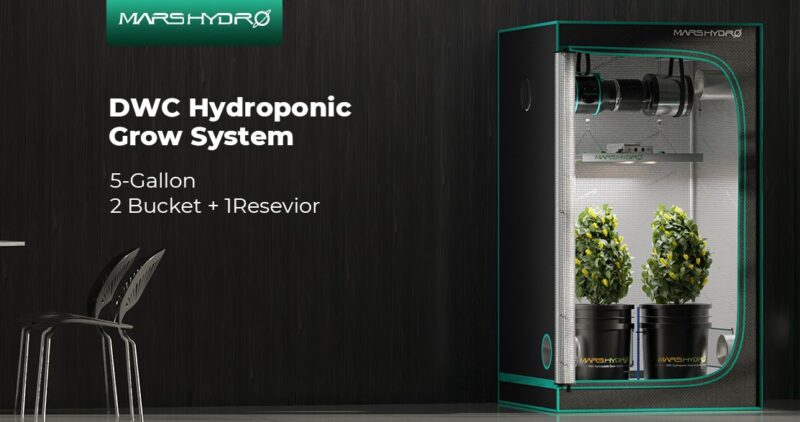
DWC hydroponics
These products from Mars Hydro provide an excellent foundation for building or expanding your hydroponic garden, offering ease of use and consistent results that can help you achieve a thriving indoor garden.
What is Traditional Soil Gardening?
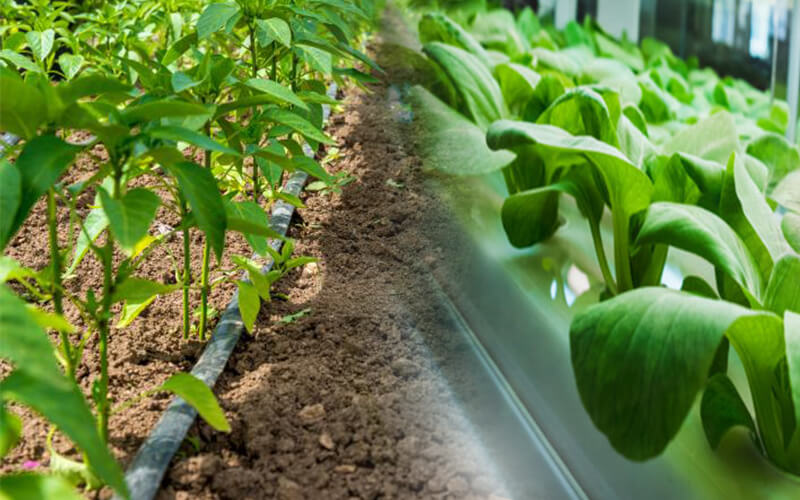
Traditional soil gardening is the conventional method of growing plants in soil. The soil acts as both a nutrient reservoir and a medium to support the plants. It naturally contains a mix of organic matter, minerals, and microorganisms that contribute to healthy plant growth. Gardeners add fertilizers, compost, and other amendments to improve soil quality and ensure plants get the nutrients they need.
Soil gardening is practiced worldwide, from small backyard gardens to large-scale agricultural fields. It’s a time-tested method that many gardeners prefer for its simplicity and connection to nature.
Key Differences Between Hydroponic and Soil Gardening
1. Growing Medium
○ Hydroponic Gardening: Plants grow in a nutrient solution, with roots suspended in water or supported by an inert medium. This method eliminates the need for soil and allows for precise control over the nutrients provided to the plants.
○ Soil Gardening: Plants grow in soil, which provides nutrients, water, and support. The quality of the soil directly affects plant health, and gardeners must manage soil fertility and structure to achieve optimal results.
2. Water Usage
○ Hydroponic Gardening: Hydroponics is highly water-efficient. The nutrient solution is recirculated, and water loss is minimal due to evaporation and transpiration. This makes hydroponic systems ideal for regions with limited water resources.
○ Soil Gardening: Soil gardening generally requires more water. Water can be lost through evaporation, runoff, and deep percolation beyond the root zone. However, soil can retain moisture for longer periods, reducing the frequency of watering in some cases.
3. Nutrient Management
○ Hydroponic Gardening: In hydroponic systems, nutrients are delivered directly to the roots in a water-based solution. This allows for precise control over nutrient levels, which can result in faster plant growth and higher yields. However, monitoring and adjusting nutrient levels is crucial to prevent deficiencies or toxicities.
○ Soil Gardening: Nutrients in soil come from organic matter, fertilizers, and soil amendments. The nutrient availability depends on factors like soil pH, texture, and microbial activity. While soil can buffer nutrient fluctuations, imbalances can still occur, requiring careful management.
4. Space Requirements
○ Hydroponic Gardening: Hydroponic systems can be set up in smaller spaces, making them ideal for urban environments, balconies, or indoor gardens. Vertical hydroponic systems allow for stacking plants, maximizing space and yield.
○ Soil Gardening: Traditional soil gardening typically requires more space, especially for larger gardens. However, raised beds, containers, and small plots can be used to grow plants in limited spaces.
5. Maintenance and Labor
○ Hydroponic Gardening: Hydroponics requires regular monitoring of water quality, nutrient levels, and system components. While the labor involved can be more technical, the absence of weeding and reduced pest issues can lower overall maintenance.
○ Soil Gardening: Soil gardening involves tasks such as weeding, tilling, and soil amendment. It also requires attention to pests and diseases that can be more prevalent in soil-based systems. However, many gardeners enjoy the hands-on nature of soil gardening as part of the experience.
6. Plant Growth and Yield
○ Hydroponic Gardening: Plants grown hydroponically often experience faster growth and higher yields due to the efficient delivery of nutrients and water. This method is particularly effective for growing leafy greens, herbs, and vegetables.
○ Soil Gardening: While soil-grown plants may grow more slowly compared to hydroponics, they can develop strong root systems and robust structures. Soil gardening is well-suited for a wide variety of plants, including perennials, flowers, and deep-rooted crops.
7. Initial Cost and Setup
○ Hydroponic Gardening: The initial cost of setting up a hydroponic system can be higher due to the need for specialized equipment, such as pumps, reservoirs, and grow lights (if indoors). However, the long-term savings on water and fertilizers can offset these costs.
○ Soil Gardening: Soil gardening typically has lower upfront costs, especially if you’re using existing garden space. Basic tools, seeds, and soil amendments are often the main expenses. However, ongoing costs may include water, fertilizers, and pest control.
Verdict: Which Method is Right for You?
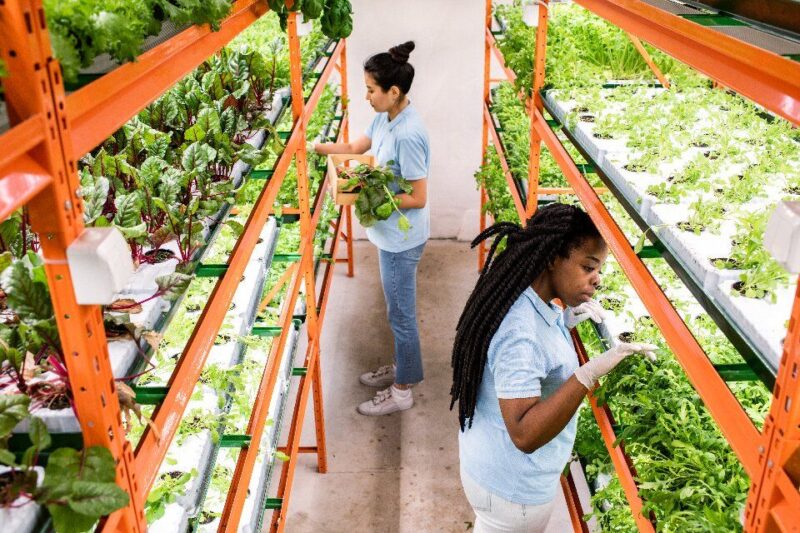
The decision between hydroponic gardening and traditional soil gardening ultimately depends on your specific needs, preferences, and environment. Here are some considerations to help you choose:
● Space and Location: If you have limited space or want to grow indoors, hydroponics might be the better option. Hydroponic systems can be tailored to fit small spaces and can be used year-round indoors.
● Water Availability: In areas where water is scarce, hydroponics offers a more water-efficient solution. If you have access to plenty of water and enjoy the natural feel of soil, traditional gardening might be more appealing.
● Time and Commitment: Hydroponics requires regular monitoring and technical knowledge, making it suitable for gardeners who enjoy a more controlled environment. Soil gardening is more hands-on and can be less demanding in terms of technology, but it requires ongoing maintenance.
● Plant Preferences: Certain plants thrive better in hydroponic systems, particularly fast-growing vegetables and herbs. If you’re growing a diverse garden that includes flowers, perennials, and deep-rooted plants, soil gardening might be more versatile.
● Budget: Consider your budget for initial setup and ongoing costs. Hydroponics can be more expensive to start, but it offers long-term savings. Soil gardening has lower startup costs but may require more resources over time.
